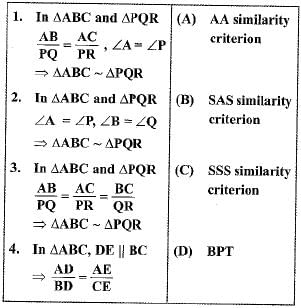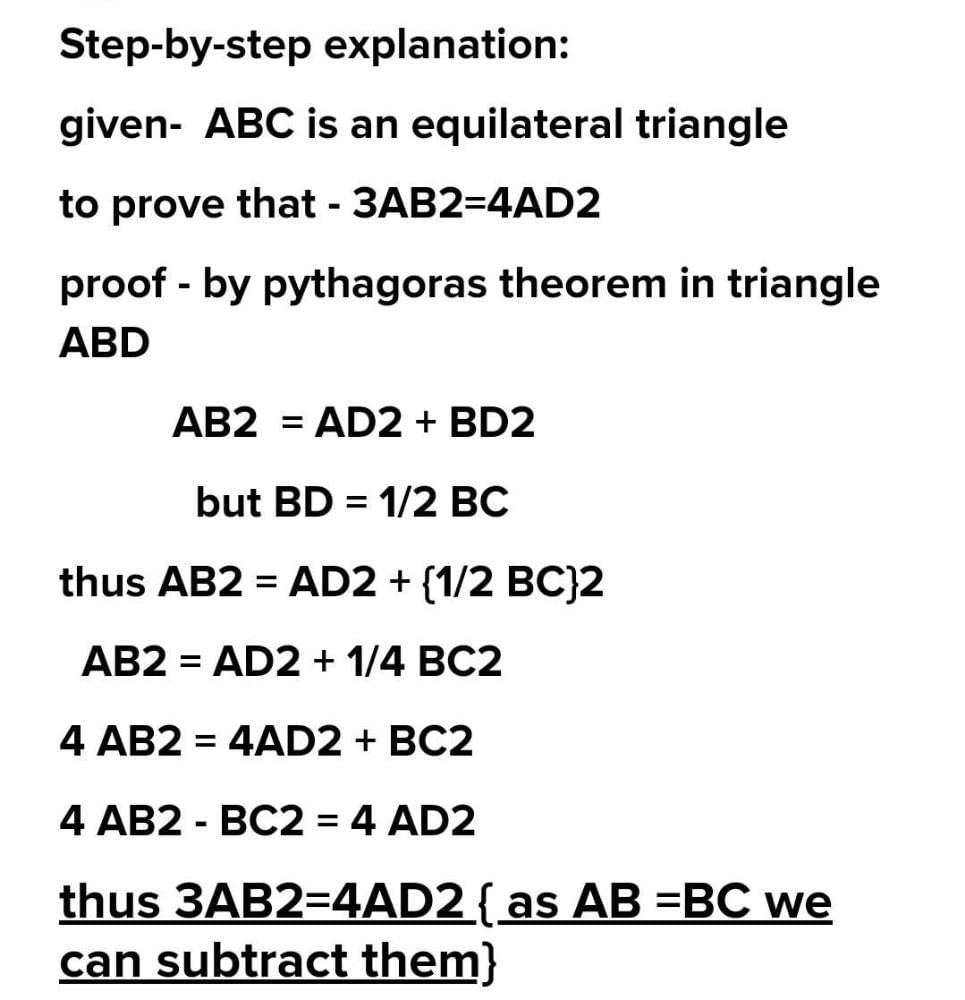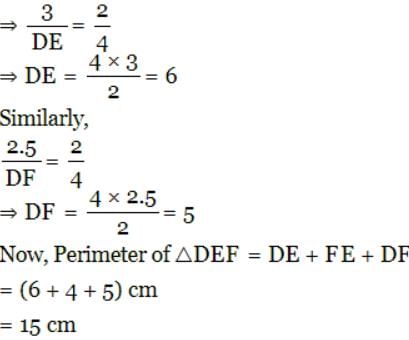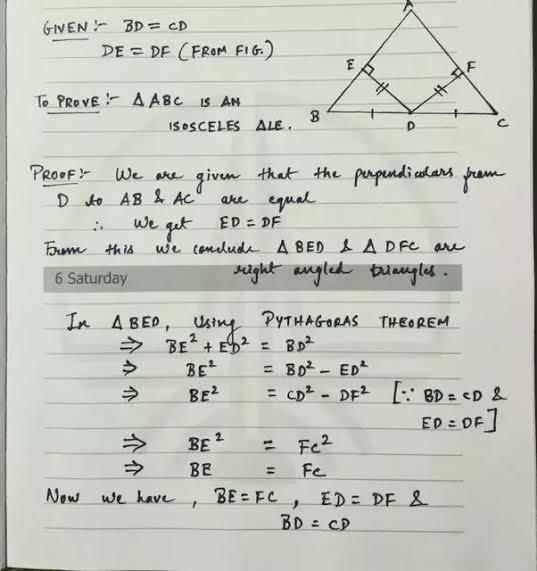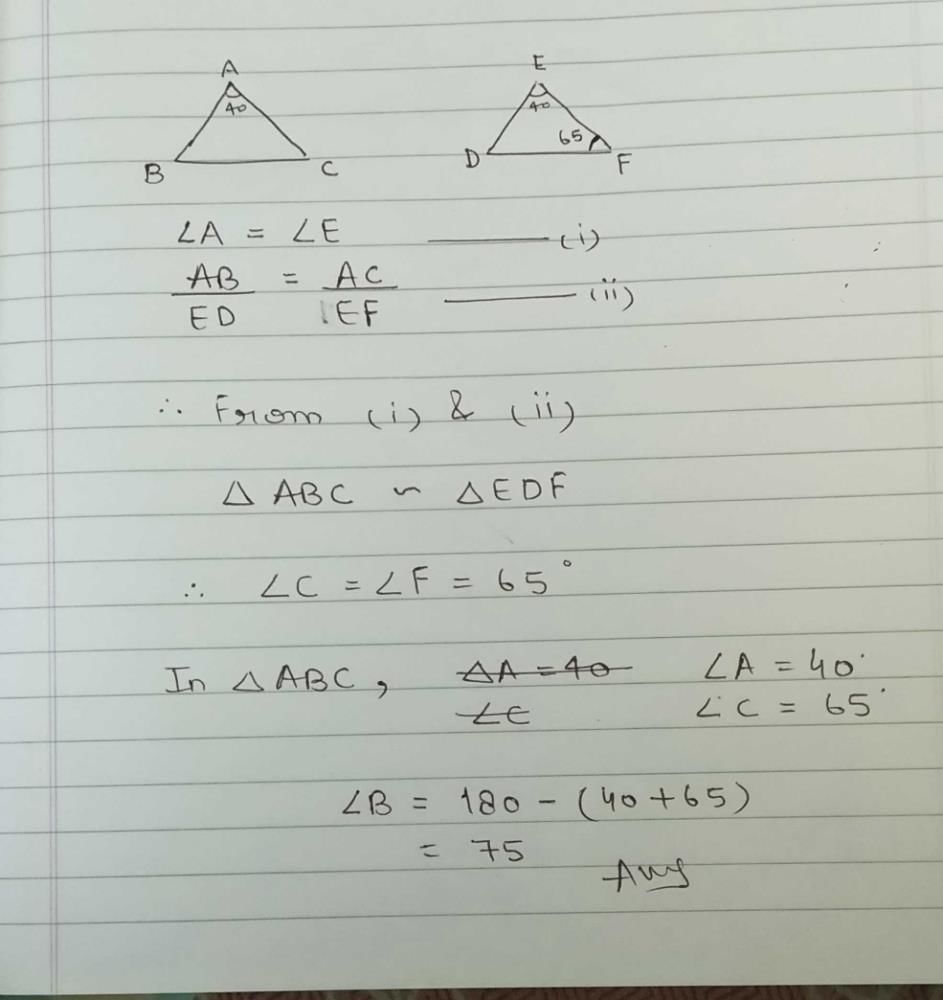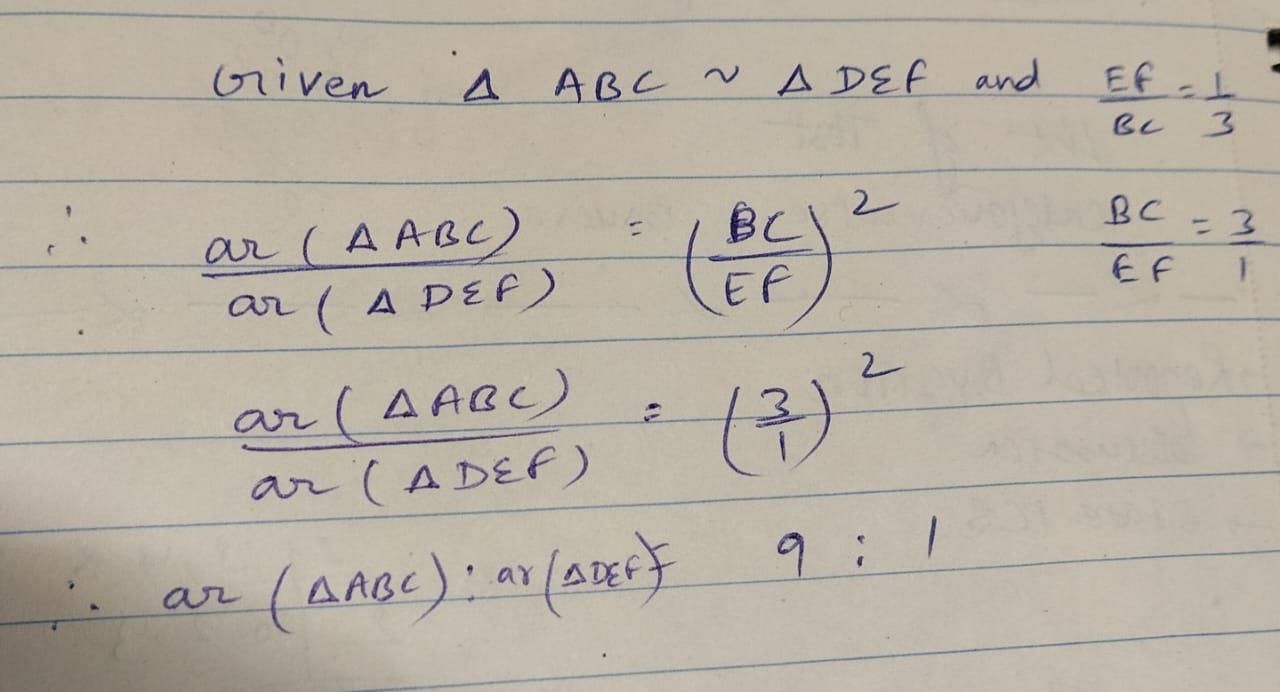All Exams >
Class 10 >
Mathematics (Maths) Class 10 >
All Questions
All questions of Triangles for Class 10 Exam
Direction: In the following questions, A statement of Assertion (A) is followed by a statement of Reason (R). Mark the correct choice as.Assertion (A): Corresponding sides of two similar triangles are in the ratio of 2 : 3. If the area of the smaller triangle is 48 cm2, then the area of the larger triangle is 108 cm2.Reason (R): If D is a point on the side BC of a triangle ABC such that ∠ADC = ∠BAC, then CA2 = CB × CD.- a)Both A and R are true and R is the correct explanation of A
- b)Both A and R are true but R is NOT the correct explanation of A
- c)A is true but R is false
- d)A is false and R is True
Correct answer is option 'B'. Can you explain this answer?
Direction: In the following questions, A statement of Assertion (A) is followed by a statement of Reason (R). Mark the correct choice as.
Assertion (A): Corresponding sides of two similar triangles are in the ratio of 2 : 3. If the area of the smaller triangle is 48 cm2, then the area of the larger triangle is 108 cm2.
Reason (R): If D is a point on the side BC of a triangle ABC such that ∠ADC = ∠BAC, then CA2 = CB × CD.
a)
Both A and R are true and R is the correct explanation of A
b)
Both A and R are true but R is NOT the correct explanation of A
c)
A is true but R is false
d)
A is false and R is True
|
|
Krishna Iyer answered |
In case of assertion

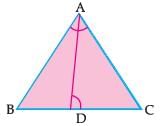
Let ΔABC and ΔDEF are two similar triangles.

Given that ar ΔABC = 48 cm2. Then,

Thus, the area of larger triangle is 108 cm2.
∴ Assertion is correct.
In case of reason:

In ΔBAC and ΔADC,
∠BAC= ∠ADC [Given]
∠BCA= ∠ACD [Common angle]
By AA similarity, ΔBAC ~ ΔADC
Thus,
CA/CD = BC/CA
∴ Reason is correct.
Hence, both assertion and reason are correct but reason is not the correct explanation for assertion.
If  BC = 21 cm, then EF is equal to
BC = 21 cm, then EF is equal to- a)9 cm
- b)6 cm
- c)35 cm
- d)25 cm
Correct answer is option 'C'. Can you explain this answer?
If  BC = 21 cm, then EF is equal to
BC = 21 cm, then EF is equal to
 BC = 21 cm, then EF is equal to
BC = 21 cm, then EF is equal toa)
9 cm
b)
6 cm
c)
35 cm
d)
25 cm

|
Imk Pathshala answered |
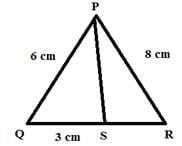
Since, PS is the angle bisector of angle QPR
So, by angle bisector theorem,
QS/SR = PQ/PR
⇒ 3/SR = 6/8
⇒ SR = (3 X 8)/6 cm = 4 cm
It is given that ar(ΔABC) = 81 square units and ar(ΔDEF) = 64 square units. If ΔABC ~ ΔDEF, then- a)AB/DE = 81/64
- b)

- c)AB/DE = 9/8
- d)AB = 81 units, DE = 64 units
Correct answer is option 'C'. Can you explain this answer?
It is given that ar(ΔABC) = 81 square units and ar(ΔDEF) = 64 square units. If ΔABC ~ ΔDEF, then
a)
AB/DE = 81/64
b)

c)
AB/DE = 9/8
d)
AB = 81 units, DE = 64 units

|
Imk Pathshala answered |
In triangle ACB and ADC
∠A=∠A
∠ACB = ∠CDA
Therefore triangle ACB and ADC are similar,
Hence
AC/AD = AB/AC
AC2 = AD X AB
82 = 3 x AB
⇒ AB = 64/3
This implies,
BD = 64/3 – AD
⇒ BD = 55/3
∠A=∠A
∠ACB = ∠CDA
Therefore triangle ACB and ADC are similar,
Hence
AC/AD = AB/AC
AC2 = AD X AB
82 = 3 x AB
⇒ AB = 64/3
This implies,
BD = 64/3 – AD
⇒ BD = 55/3
Which geometric figures are always similar?- a)Circles
- b)Circles and all regular polygons
- c)Circles and triangles
- d)Regular polygons
Correct answer is option 'B'. Can you explain this answer?
Which geometric figures are always similar?
a)
Circles
b)
Circles and all regular polygons
c)
Circles and triangles
d)
Regular polygons
|
|
Raghav Bansal answered |
It can be found that circles map one onto another.So they are similar figures. A regular polygon is a polygon which has the same sides and equal measures of angles. So they are also similar.
In triangle ABC, if AB = 6√3 cm, AC = 12 cm and BC cm, then ∠B is - a)120°
- b)60°
- c)90°
- d)45°
Correct answer is option 'C'. Can you explain this answer?
In triangle ABC, if AB = 6√3 cm, AC = 12 cm and BC cm, then ∠B is
a)
120°
b)
60°
c)
90°
d)
45°
|
|
Gaurav Kumar answered |
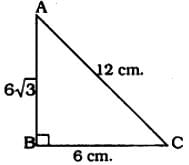
Here largest side is 12 cm.
If the square of the hypotenuse is equal to the square of the other two sides, then it is a right-angled triangle.
If the square of the hypotenuse is equal to the square of the other two sides, then it is a right-angled triangle.
∴ c2 = a2 + b2
AC2 = AB2 + BC2
(12)2 = (63)2 + (6)2
44 = 36 × 3 + 36
144 = 108 + 36
144 = 144
∴ ∆ABC is a right angled triangle and angle opposite to hypotenuse, ∠B = 90°.
ΔABC ~ ΔPQR, ∠B = 50° and ∠C = 70° then ∠P is equal to- a)50°
- b)60°
- c)40°
- d)70°
Correct answer is option 'B'. Can you explain this answer?
ΔABC ~ ΔPQR, ∠B = 50° and ∠C = 70° then ∠P is equal to
a)
50°
b)
60°
c)
40°
d)
70°
|
|
Radha Iyer answered |
Similar triangles have corresponding angles equal. So Angle Q=Angle B = 50° and Angle R = Angle C = 70° . So by angle sum property, Angle P+Angle Q +Angle R = 180°
Angle P=180° - 50° - 70° = 60°
Angle P=180° - 50° - 70° = 60°
Which pair of the given quadrilaterals is similar?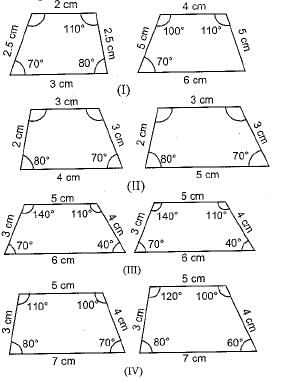
a)I only
b)III onlyc)I and IIId)IVCorrect answer is option 'C'. Can you explain this answer?

|
|
Naina Sharma answered |
Quadrilaterals are similar if their angles are equal and corresponding sides are proportional.
Two congruent triangles are actually similar triangles with the ratio of corresponding sides as.- a)1:2
- b)1:1
- c)1:3
- d)2:1
Correct answer is option 'B'. Can you explain this answer?
Two congruent triangles are actually similar triangles with the ratio of corresponding sides as.
a)
1:2
b)
1:1
c)
1:3
d)
2:1
|
|
Pushkar tiwari answered |
Similar Triangles and Corresponding Sides
Similar triangles are those triangles that have the same shape but may have different sizes. When two triangles are similar, the corresponding angles are the same, and the corresponding sides are proportional. In other words, the ratio of the lengths of the corresponding sides is the same for all pairs of corresponding sides. This ratio is called the scale factor.
Given the statement that "Two congruent triangles are actually similar triangles with the ratio of corresponding sides as," we are asked to determine the scale factor for the corresponding sides of the two triangles.
Option B is the correct answer, and the scale factor is 1:1. This means that the corresponding sides of the two triangles are equal in length.
Explanation of Other Options:
a) 1:2 - This means that the corresponding sides of one triangle are twice as long as the corresponding sides of the other triangle. Therefore, the triangles are not congruent, but they are similar.
c) 1:3 - This means that the corresponding sides of one triangle are three times as long as the corresponding sides of the other triangle. Therefore, the triangles are not congruent, but they are similar.
d) 2:1 - This means that the corresponding sides of one triangle are half as long as the corresponding sides of the other triangle. Therefore, the triangles are not congruent, but they are similar.
Conclusion:
In summary, when two triangles are congruent, they are also similar with a scale factor of 1:1. This means that the corresponding sides of the triangles are equal in length.
Similar triangles are those triangles that have the same shape but may have different sizes. When two triangles are similar, the corresponding angles are the same, and the corresponding sides are proportional. In other words, the ratio of the lengths of the corresponding sides is the same for all pairs of corresponding sides. This ratio is called the scale factor.
Given the statement that "Two congruent triangles are actually similar triangles with the ratio of corresponding sides as," we are asked to determine the scale factor for the corresponding sides of the two triangles.
Option B is the correct answer, and the scale factor is 1:1. This means that the corresponding sides of the two triangles are equal in length.
Explanation of Other Options:
a) 1:2 - This means that the corresponding sides of one triangle are twice as long as the corresponding sides of the other triangle. Therefore, the triangles are not congruent, but they are similar.
c) 1:3 - This means that the corresponding sides of one triangle are three times as long as the corresponding sides of the other triangle. Therefore, the triangles are not congruent, but they are similar.
d) 2:1 - This means that the corresponding sides of one triangle are half as long as the corresponding sides of the other triangle. Therefore, the triangles are not congruent, but they are similar.
Conclusion:
In summary, when two triangles are congruent, they are also similar with a scale factor of 1:1. This means that the corresponding sides of the triangles are equal in length.
If ΔABC ~ ΔEDF then which of the following is not true?
- a)BC . EF = AC . FD
- b)AB . EF = AC . DE
- c)BC . DE = AB . EF
- d)BC . DE = AB . FD
Correct answer is option 'C'. Can you explain this answer?
If ΔABC ~ ΔEDF then which of the following is not true?
a)
BC . EF = AC . FD
b)
AB . EF = AC . DE
c)
BC . DE = AB . EF
d)
BC . DE = AB . FD
|
|
Anita Menon answered |
Since △ABC~△EDF
Then, AB/ED = BC/DF = AC/EF
A) BC/DF = AC/EF
⇒BC.EF=AC.FD
So, A) is true
B) AB/ED = AC/EF
⇒AB.EF=AC.DE
So,B) is true
D) AB/ED = BC/DF
BC.DE=AB.EF
So, D) is not true
Therefore, Option C is not true
In triangles ABC and DEF, ∠B = ∠E, ∠F = ∠C and AB = 3DE. Then, the two triangles are- a)congruent but not similar
- b)similar but not congruent
- c)neither congruent nor similar
- d)congruent as well as similar
Correct answer is option 'B'. Can you explain this answer?
In triangles ABC and DEF, ∠B = ∠E, ∠F = ∠C and AB = 3DE. Then, the two triangles are
a)
congruent but not similar
b)
similar but not congruent
c)
neither congruent nor similar
d)
congruent as well as similar
|
|
Kiran Mehta answered |
to be congruent, the conditions are
S S S - three sides
S A S - two sides and the included angle
A S A - two angles and one side
R H S - R H S - Right angle, Hypotenuse and one side
But to be similar,
A A A means 3 angles
A A means only two angles ....
in both triangles should be equal.
In the problem, equality of two angles is given, but equality of sides is not given.
So, given triangles are not congruent.
But they are similar.
S S S - three sides
S A S - two sides and the included angle
A S A - two angles and one side
R H S - R H S - Right angle, Hypotenuse and one side
But to be similar,
A A A means 3 angles
A A means only two angles ....
in both triangles should be equal.
In the problem, equality of two angles is given, but equality of sides is not given.
So, given triangles are not congruent.
But they are similar.
In the given figure, AD/BD = AE/EC and ∠ADE = 70°, ∠BAC = 50°, then angle ∠BCA =

- a)70°
- b)50°
- c)80°
- d)60°
Correct answer is option 'D'. Can you explain this answer?
In the given figure, AD/BD = AE/EC and ∠ADE = 70°, ∠BAC = 50°, then angle ∠BCA =


a)
70°
b)
50°
c)
80°
d)
60°
|
|
Trisha sharma answered |
Explanation: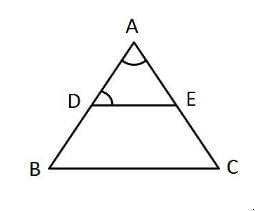
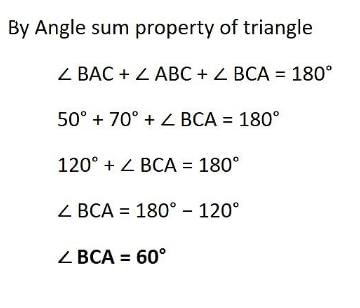

By converse of Thale’s theorem DE II BC
∠ADE = ∠ABC = 70 degree
Given ∠BAC = 50 degree

You can read Important Definitions & Formulas related to Triangles through the document:
In ΔLMN and ΔPQR, ∠L = ∠P, ∠N = ∠R and MN = 2QR. Then the two triangles are- a)Congruent but not similar
- b)Similar but not congruent
- c)neither congruent nor similar
- d)Congrunt as well as similar
Correct answer is option 'B'. Can you explain this answer?
In ΔLMN and ΔPQR, ∠L = ∠P, ∠N = ∠R and MN = 2QR. Then the two triangles are
a)
Congruent but not similar
b)
Similar but not congruent
c)
neither congruent nor similar
d)
Congrunt as well as similar

|
EduRev Class 10 answered |
According to question,
ΔABC ~ ΔDEF,
AB = 4 cm, DE = 6 cm, EF = 9 cm and FD = 12 cm,
Therefore,
AB/DE = BC/EF = AC/DF
4/6 = BC/9 = AC/12
⇒ 4/6 = BC/9
⇒ BC = 6 cm
And
4/6 = AC/12
⇒ AC = 8 cm
Perimeter = AB + BC + CA
= 4 + 6 + 8
= 18 cm
ΔABC ~ ΔDEF,
AB = 4 cm, DE = 6 cm, EF = 9 cm and FD = 12 cm,
Therefore,
AB/DE = BC/EF = AC/DF
4/6 = BC/9 = AC/12
⇒ 4/6 = BC/9
⇒ BC = 6 cm
And
4/6 = AC/12
⇒ AC = 8 cm
Perimeter = AB + BC + CA
= 4 + 6 + 8
= 18 cm
D and E are respectively the points on the sides AB and AC of a triangle ABC such that AD = 3 cm, BD = 5 cm, BC = 12.8 cm and DE || BC. Then length of DE (in cm) is- a)4.8 cm
- b)7.6 cm
- c)19.2 cm
- d)2.5 cm
Correct answer is option 'A'. Can you explain this answer?
D and E are respectively the points on the sides AB and AC of a triangle ABC such that AD = 3 cm, BD = 5 cm, BC = 12.8 cm and DE || BC. Then length of DE (in cm) is
a)
4.8 cm
b)
7.6 cm
c)
19.2 cm
d)
2.5 cm
|
|
Meera Rana answered |
GIVEN: In Δ ABC, D and E are points on AB and AC , DE || BC and AD = 2.4 cm, AE = 3.2 cm, DE = 2 cm and BE = 5 cm.
In Δ ADE and Δ ABC,
∠ADE =∠ABC (corresponding angles)
[DE || BC, AB is transversal]
∠AED =∠ACB (corresponding angles)
[DE || BC, AC is transversal]
So, Δ ADE ~ Δ ABC (AA similarity)
Therefore, AD/AB = AE/AC = DE/BC
[In similar triangles corresponding sides are proportional]
AD/AB = DE/BC
2.4/(2.4+DB) = 2/5
2.4 × 5 = 2(2.4+ DB)
12 = 4.8 + 2DB
12 - 4.8 = 2DB
7.2 = 2DB
DB = 7.2/2
DB = 3.6 cm
Similarly, AE/AC = DE/BC
3.2/(3.2+EC) = 2/5
3.2 × 5 = 2(3.2+EC)
16 = 6.4 + 2EC
16 - 6.4 = 2EC
9.6 = 2EC
EC = 9.6/2
EC = 4.8 cm
Hence,BD = 3.6 cm and CE = 4.8 cm.
In Δ ADE and Δ ABC,
∠ADE =∠ABC (corresponding angles)
[DE || BC, AB is transversal]
∠AED =∠ACB (corresponding angles)
[DE || BC, AC is transversal]
So, Δ ADE ~ Δ ABC (AA similarity)
Therefore, AD/AB = AE/AC = DE/BC
[In similar triangles corresponding sides are proportional]
AD/AB = DE/BC
2.4/(2.4+DB) = 2/5
2.4 × 5 = 2(2.4+ DB)
12 = 4.8 + 2DB
12 - 4.8 = 2DB
7.2 = 2DB
DB = 7.2/2
DB = 3.6 cm
Similarly, AE/AC = DE/BC
3.2/(3.2+EC) = 2/5
3.2 × 5 = 2(3.2+EC)
16 = 6.4 + 2EC
16 - 6.4 = 2EC
9.6 = 2EC
EC = 9.6/2
EC = 4.8 cm
Hence,BD = 3.6 cm and CE = 4.8 cm.
If PQR is an isosceles triangle and M is a point on QR such that PM⊥QR,then- a)PQ2−PM2 = QM2−MR2.
- b)PQ2+PM2 = QM.MR.
- c)PQ2−PR2 = QM2 − MR2
- d)PQ2−PM2 = QM.MR.
Correct answer is option 'C'. Can you explain this answer?
If PQR is an isosceles triangle and M is a point on QR such that PM⊥QR,then
a)
PQ2−PM2 = QM2−MR2.
b)
PQ2+PM2 = QM.MR.
c)
PQ2−PR2 = QM2 − MR2
d)
PQ2−PM2 = QM.MR.
|
|
Krishna Iyer answered |
Since, in a triangle the sum of squares of any wo sides is equal to twice the square of half of the third side together with twice the square of the median bisecting it.
In ΔPQM,
In ΔPQM,
The areas of two similar triangles are 100cm2 and 49 cm2. If the altitude of the larger triangle is 5 cm, then the corresponding altitude of the other triangle is equal to- a)3.5 cm.
- b)3.9 cm.
- c)5.4 cm.
- d)4.5 cm.
Correct answer is option 'A'. Can you explain this answer?
The areas of two similar triangles are 100cm2 and 49 cm2. If the altitude of the larger triangle is 5 cm, then the corresponding altitude of the other triangle is equal to
a)
3.5 cm.
b)
3.9 cm.
c)
5.4 cm.
d)
4.5 cm.
|
|
Krishna Iyer answered |
Let the two similar triangles be ΔABC and ΔDEF such that ar(ΔABC) = 100 cm2 and ar(ΔDEF) = 49 cm2.
Let AM and DN be the respective altitudes of ΔABC and ΔDEF.
Since the ratio of the areas of two similar triangles is equal to the ratio of the squares of their corresponding altitudes
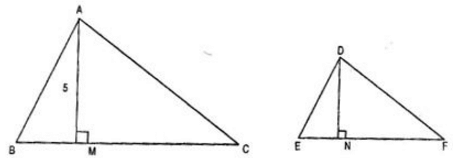
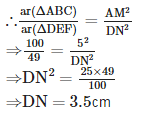
Let AM and DN be the respective altitudes of ΔABC and ΔDEF.
Since the ratio of the areas of two similar triangles is equal to the ratio of the squares of their corresponding altitudes
If in triangles ABC and DEF, AB/EF = AC/DE, then they will be similar when- a)∠A = ∠D
- b)∠A = ∠E
- c)∠B = ∠E
- d)∠C = ∠F
Correct answer is option 'B'. Can you explain this answer?
If in triangles ABC and DEF, AB/EF = AC/DE, then they will be similar when
a)
∠A = ∠D
b)
∠A = ∠E
c)
∠B = ∠E
d)
∠C = ∠F

|
Crafty Classes answered |
The altitude divides the opposite side into two equal parts,
Therefore, BD = DC = 4 cm
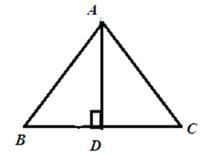
In triangle ABD
AB2 = AD2 + BD2
82 = AD2 + 42
AD2 = 64 – 16
AD2 = 48
AD = 4√3 cm
Therefore, BD = DC = 4 cm

In triangle ABD
AB2 = AD2 + BD2
82 = AD2 + 42
AD2 = 64 – 16
AD2 = 48
AD = 4√3 cm
A square and a rhombus are always - a)similar
- b)congruent
- c)similar but not congruent
- d)neither similar nor congruent
Correct answer is option 'D'. Can you explain this answer?
A square and a rhombus are always
a)
similar
b)
congruent
c)
similar but not congruent
d)
neither similar nor congruent

|
Kamna Science Academy answered |
Let AC be the ladder of length 5m and BC = 4m be the height of the wall where ladder is placed. If the foot of the ladder is moved 1.6m towards the wall i.e. AD = 1.6 m, then the ladder is slided upward to position E i.e. CE = x m.
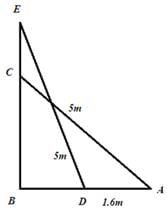
In right triangle ABC
AC2 = AB2 + BC2
⇒52 = AB2 + 42
⇒ AB = 3m
⇒ DB = AB – AD = 3 – 1.6 = 1.4m
In right angled ΔEBD
ED2 = EB2 + BD2
⇒ 52 = EB2 + (1.4)2
⇒ EB = 4.8m
EC = EB – BC = 4.8 – 4 = 0.8m

In right triangle ABC
AC2 = AB2 + BC2
⇒52 = AB2 + 42
⇒ AB = 3m
⇒ DB = AB – AD = 3 – 1.6 = 1.4m
In right angled ΔEBD
ED2 = EB2 + BD2
⇒ 52 = EB2 + (1.4)2
⇒ EB = 4.8m
EC = EB – BC = 4.8 – 4 = 0.8m
In right triangle ABC, right angled at A,A perpendicular is dropped from A to BC, meeting BC at D. Then which of the following is true?- a)ΔADC ~ ΔABD
- b)ΔDCA ~ ΔDABD
- c)ΔDAC ~ ΔDABD
- d)ΔDAC ~ ΔDABA
Correct answer is option 'D'. Can you explain this answer?
In right triangle ABC, right angled at A,
A perpendicular is dropped from A to BC, meeting BC at D. Then which of the following is true?
a)
ΔADC ~ ΔABD
b)
ΔDCA ~ ΔDABD
c)
ΔDAC ~ ΔDABD
d)
ΔDAC ~ ΔDABA
|
|
Naina kapoor answered |
Explanation:
- Let's draw the diagram first.
- From the diagram, we can see that triangle ABD and triangle ACD are both right triangles.
- Therefore, we can use the Pythagorean theorem to find their sides.
- Let's assume that AB = b, AC = c, and BC = a.
- Using Pythagorean theorem, we get:
- AB² + BD² = AD² (for triangle ABD)
- AC² + CD² = AD² (for triangle ACD)
- BC² = AB² + AC² (by Pythagoras theorem)
- Now, we can simplify the above equations to get:
- BD² = AD² - AB² = (AC² + CD²) - AB²
- CD² = AD² - AC² = (AB² + BD²) - AC²
- Substituting the value of BD² and CD² in the above equations, we get:
- AB² + (AC² + CD² - AB²) = AD²
- AC² + (AB² + BD² - AC²) = AD²
- After simplifying, we get:
- AC² = AD² - AB²
- AB² = AD² - AC²
- Therefore, we can say that triangle DAC is similar to triangle DAB by the Angle-Angle-Similarity criterion.
- Thus, option D is the correct answer.
In the given fig, P and Q are points on the sides AB and AC respectively of Δ ABC such that AP = 3.5 cm, PB = 7 cm, AQ = 3 cm and QC = 6 cm. If PQ = 4.5 cm, find BC.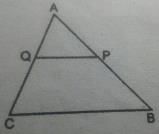
- a)13.5 cme
- b)2. 6 cm
- c)3.4 cm
- d)1. 6 cm
Correct answer is option 'A'. Can you explain this answer?
In the given fig, P and Q are points on the sides AB and AC respectively of Δ ABC such that AP = 3.5 cm, PB = 7 cm, AQ = 3 cm and QC = 6 cm. If PQ = 4.5 cm, find BC.

a)
13.5 cme
b)
2. 6 cm
c)
3.4 cm
d)
1. 6 cm

|
Rahul Kumar answered |

Therefore, by converse of Basic Proportionality Theorem, we have QP || CB
Hence, ∆AQP ~ ∆ACB [Using AA similar condition]
∴ 
⇒
⇒

⇒

⇒

The line segments joining the mid points of the sides of a triangle form four triangles each of which is :- a)Similar to the original triangle
- b)Congruent to the original triangle
- c)An equilateral triangle
- d)An isosceles triangle
Correct answer is option 'A'. Can you explain this answer?
The line segments joining the mid points of the sides of a triangle form four triangles each of which is :
a)
Similar to the original triangle
b)
Congruent to the original triangle
c)
An equilateral triangle
d)
An isosceles triangle
|
|
Krishna Iyer answered |
Given :△ABC, D, E and F are mid points of AB, BC, CA respectively.
Using mid point theorem we prove that □ADEF, □DBEF and □DECF are parallelograms. The diagonal of a parallelogram divides the parallelogram into two congruent triangles. So all triangles are congruent to each other. And each small triangle is similar to the original triangle.
Using mid point theorem we prove that □ADEF, □DBEF and □DECF are parallelograms. The diagonal of a parallelogram divides the parallelogram into two congruent triangles. So all triangles are congruent to each other. And each small triangle is similar to the original triangle.
In ΔABC, AB = 5 cm, AC = 7 cm. If AD is the angle bisector of ∠A. Then BD : CD is:- a)25 : 49
- b)49 : 25
- c)6 : 1
- d)5 : 7
Correct answer is option 'D'. Can you explain this answer?
In ΔABC, AB = 5 cm, AC = 7 cm. If AD is the angle bisector of ∠A. Then BD : CD is:
a)
25 : 49
b)
49 : 25
c)
6 : 1
d)
5 : 7

|
Saumya Chakraborty answered |
In ∆ABC ,if AD is angle bisector of angle A,
Then ,AB:AC=BD:DC (by internal angle bisector theorem)
Then ,BD=5cm ,BC=7:5 cm
=>DC=7.5-5=2.5
AB:AC=BD:DC=5:2.5=2:1
In ΔABC, AB = 3 cm, AC = 4 cm and AD is the bisector of ∠A. Then, BD : DC is :
- a)9 : 16
- b)16 : 9
- c)3 : 4
- d)4 : 3
Correct answer is option 'C'. Can you explain this answer?
In ΔABC, AB = 3 cm, AC = 4 cm and AD is the bisector of ∠A. Then, BD : DC is :
a)
9 : 16
b)
16 : 9
c)
3 : 4
d)
4 : 3

|
Let's Tute answered |
The angle bisector theoremstates that an angle bisector divides the opposite side of a triangle into two segments that are proportional to the triangle's other two sides. In other words,
AB/BD = AC/CD.
Now
AB/AC=BD/DC
Which is the required ratio .
Thats how BD/DC=3/4
AB/BD = AC/CD.
Now
AB/AC=BD/DC
Which is the required ratio .
Thats how BD/DC=3/4
A semicircle is drawn on AC. Two chords AB and BC of length 8 cm and 6 cm respectively are drawn in the semicircle. What is the measure of the diameter of the circle?- a)14 cm.
- b)10 cm.
- c)12 cm.
- d)11 cm.
Correct answer is option 'B'. Can you explain this answer?
A semicircle is drawn on AC. Two chords AB and BC of length 8 cm and 6 cm respectively are drawn in the semicircle. What is the measure of the diameter of the circle?
a)
14 cm.
b)
10 cm.
c)
12 cm.
d)
11 cm.
|
|
Krishna Iyer answered |
The diameter of circle is AC. Here ∠ABC is angle of semicircle.
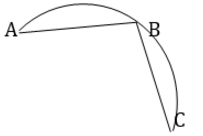
AB ∴ ∠ ABC = 90° ∴ Δ ABC is aright angled triangle.

 10 cm
10 cm
AB ∴ ∠ ABC = 90° ∴ Δ ABC is aright angled triangle.

 10 cm
10 cmIf ΔPRQ ~ ΔXYZ, then- a)

- b)

- c)

- d)

Correct answer is option 'C'. Can you explain this answer?
If ΔPRQ ~ ΔXYZ, then
a)

b)

c)

d)

|
|
Kuldeep Kuldeep answered |
Since the two triangles are similar, therefore, they will have their corresponding angles congruent and the corresponding sides in proportion.
Direction: In the following questions, A statement of Assertion (A) is followed by a statement of Reason (R). Mark the correct choice as.Assertion : ABC is an isosceles, right triangle, right angled at C . Then AB2 = 3AC2Reason : In an isosceles triangle ABC if AC = BC and AB2 = 2AC2 , then ∠C = 90°- a)Both A and R are true and R is the correct explanation of A
- b)Both A and R are true but R is NOT the correct explanation of A
- c)A is true but R is false
- d)A is false and R is True
Correct answer is option 'D'. Can you explain this answer?
Direction: In the following questions, A statement of Assertion (A) is followed by a statement of Reason (R). Mark the correct choice as.
Assertion : ABC is an isosceles, right triangle, right angled at C . Then AB2 = 3AC2
Reason : In an isosceles triangle ABC if AC = BC and AB2 = 2AC2 , then ∠C = 90°
a)
Both A and R are true and R is the correct explanation of A
b)
Both A and R are true but R is NOT the correct explanation of A
c)
A is true but R is false
d)
A is false and R is True
|
|
Ishan Choudhury answered |
If Assertion is incorrect, but Reason is correct.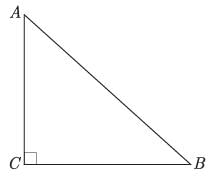
In right angled ΔABC ,

AB2 = AC2 + BC2(By Pythagoras Theorem)
= AC2 + AC2 [BC = AC]
= 2AC2AB2 = 2AC2
Assertion is false.
Again since, AB2 = 2AC2
= AC2 + AC2 = AC2 + BC2 (AC = BC given)
∠ = 90°
(By converse of Pythagoras Theorem)Reason is true.
Direction: In the following questions, A statement of Assertion (A) is followed by a statement of Reason (R). Mark the correct choice as.Assertion : The length of the side of a square whose diagonal is 16 cm, is 8√2 cmReason : In a right triangle, the square of the hypotenuse is equal to the sum of the squares of the other two sides.- a)Both A and R are true and R is the correct explanation of A
- b)Both A and R are true but R is NOT the correct explanation of A
- c)A is true but R is false
- d)A is false and R is True
Correct answer is option 'A'. Can you explain this answer?
Direction: In the following questions, A statement of Assertion (A) is followed by a statement of Reason (R). Mark the correct choice as.
Assertion : The length of the side of a square whose diagonal is 16 cm, is 8√2 cm
Reason : In a right triangle, the square of the hypotenuse is equal to the sum of the squares of the other two sides.
a)
Both A and R are true and R is the correct explanation of A
b)
Both A and R are true but R is NOT the correct explanation of A
c)
A is true but R is false
d)
A is false and R is True
|
|
Meera Rana answered |
We know that In a right triangle, the square of the hypotenuse is equal to the sum of the squares of the other two sides. This is Pythagoras theorem. So, Reason is correct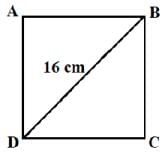

Let the side of square be x cm.
In ∆ABD, by Pythagoras theorem, we have BD2 = AB2 + AD2
⇒ 162 = x2 + x2
⇒ 2x2 = 256 ⇒ x2 = 128 ⇒ x = 8√2 cm
So, Assertion is also correct.
If AB, BC and AC be the three sides of a triangle ABC, which one of the following is true?- a)AB – BC = AC
- b)(AB – BC) > AC
- c)(AB – BC) < AC
- d)AB2 – BC2 = AC2
Correct answer is option `C`. Can you explain this answer?
If AB, BC and AC be the three sides of a triangle ABC, which one of the following is true?
a)
AB – BC = AC
b)
(AB – BC) > AC
c)
(AB – BC) < AC
d)
AB2 – BC2 = AC2
|
|
Harshad Choudhury answered |
The sum of the lengths of any two sides of a triangle is greater than the length of the third side.
AC + BC > AB
=> AC > AB - BC
which is option C.
In ΔABC and ΔDEF, ∠A = 50°, ∠B = 70°, ∠C = 60°, ∠D = 60°, ∠E = 70°, ∠F = 50°, then ΔABC is similar to:- a)ΔDEF
- b)ΔEDF
- c)ΔDFE
- d)ΔFED
Correct answer is option 'D'. Can you explain this answer?
In ΔABC and ΔDEF, ∠A = 50°, ∠B = 70°, ∠C = 60°, ∠D = 60°, ∠E = 70°, ∠F = 50°, then ΔABC is similar to:
a)
ΔDEF
b)
ΔEDF
c)
ΔDFE
d)
ΔFED
|
|
Aditya Rane answered |
The context of computer programming, a loop is a sequence of instructions that is repeated until a certain condition is met. There are different types of loops in programming, including:
1. For loop: This loop is used to execute a block of code a specific number of times. It consists of an initialization, a condition, and an increment or decrement statement.
Example:
```
for (int i = 0; i < 10;="" i++)="" />
// code to be executed
}
```
2. While loop: This loop is used to execute a block of code as long as a specified condition is true. The condition is checked before each iteration.
Example:
```
int i = 0;
while (i < 10)="" />
// code to be executed
i++;
}
```
3. Do-while loop: This loop is similar to the while loop, but the condition is checked after each iteration. This means that the code block will always be executed at least once.
Example:
```
int i = 0;
do {
// code to be executed
i++;
} while (i < />
```
Loops are useful for automating repetitive tasks and iterating over data structures, such as arrays or lists. They allow programmers to write more efficient and concise code.
1. For loop: This loop is used to execute a block of code a specific number of times. It consists of an initialization, a condition, and an increment or decrement statement.
Example:
```
for (int i = 0; i < 10;="" i++)="" />
// code to be executed
}
```
2. While loop: This loop is used to execute a block of code as long as a specified condition is true. The condition is checked before each iteration.
Example:
```
int i = 0;
while (i < 10)="" />
// code to be executed
i++;
}
```
3. Do-while loop: This loop is similar to the while loop, but the condition is checked after each iteration. This means that the code block will always be executed at least once.
Example:
```
int i = 0;
do {
// code to be executed
i++;
} while (i < />
```
Loops are useful for automating repetitive tasks and iterating over data structures, such as arrays or lists. They allow programmers to write more efficient and concise code.
In a right angled ΔABC, right angled at A, if AD ⊥ BC such that AD = p, If BC = a, CA = b and AB = c, then: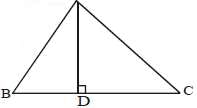
- a)p2 = b2 + c2
- b)

- c)

- d)p2 = b2 c2
Correct answer is option 'B'. Can you explain this answer?
In a right angled ΔABC, right angled at A, if AD ⊥ BC such that AD = p, If BC = a, CA = b and AB = c, then:
a)
p2 = b2 + c2
b)

c)
d)
p2 = b2 c2

|
Rohini Seth answered |
In ΔCAB and ΔADB
Angle B is common and Angle A=Angle D
So the triangles are similar

a=cb/p
Now applying pythagoras theorem in
Δ ABC
H2 = P2+B2
BC2=AC2+AB2


Angle B is common and Angle A=Angle D
So the triangles are similar

a=cb/p
Now applying pythagoras theorem in
Δ ABC
H2 = P2+B2
BC2=AC2+AB2


Sides of triangles are (i) 3 cm, 4 cm, 6 cm. (ii) 4 cm, 5 cm, 6 cm. (iii) 7 cm, 24 cm, 25 cm (iv) 5 cm, 10 cm, 14 cm. Which of these is right triangle?
- a)(i)
- b)(ii)
- c)(iii)
- d)(iv)
Correct answer is option 'C'. Can you explain this answer?
Sides of triangles are (i) 3 cm, 4 cm, 6 cm. (ii) 4 cm, 5 cm, 6 cm. (iii) 7 cm, 24 cm, 25 cm (iv) 5 cm, 10 cm, 14 cm. Which of these is right triangle?
a)
(i)
b)
(ii)
c)
(iii)
d)
(iv)
|
|
Radha Iyer answered |
On verification, triangle with sides 7 cm, 24 cm and 25 cm is a right triangle
∵ (25)2 = (7)2 + (24)2.
∵ (25)2 = (7)2 + (24)2.
Direction: In the following questions, A statement of Assertion (A) is followed by a statement of Reason (R). Mark the correct choice as.Assertion (A): If in two right triangles, one of the acute angles of one triangle is equal to an acute angle of the other triangle, then triangles will be similar.Reason (R): If the ratio of the corresponding altitudes of two similar triangles is 3/5, then theratio of their areas is 6/5.- a)Both A and R are true and R is the correct explanation of A
- b)Both A and R are true but R is NOT the correct explanation of A
- c)A is true but R is false
- d)A is false and R is True
Correct answer is option 'C'. Can you explain this answer?
Direction: In the following questions, A statement of Assertion (A) is followed by a statement of Reason (R). Mark the correct choice as.
Assertion (A): If in two right triangles, one of the acute angles of one triangle is equal to an acute angle of the other triangle, then triangles will be similar.
Reason (R): If the ratio of the corresponding altitudes of two similar triangles is 3/5, then the
ratio of their areas is 6/5.
a)
Both A and R are true and R is the correct explanation of A
b)
Both A and R are true but R is NOT the correct explanation of A
c)
A is true but R is false
d)
A is false and R is True
|
|
Meera Rana answered |
In case of assertion: In the given two right triangles, both have equal right angles and one of the acute angles of one triangle is equal to an acute angle of the other triangle.
Thus, by AA similarity, the given two triangles are similar.
∴ Assertion is correct.
In case of reason:
We know that the ratio of the areas of two similar triangles is the square of the ratio of the corresponding altitudes of two similar triangles.
Thus, the ratio of the areas of two similar triangles is (3/5)2 = 9/25.
The length of each side of a rhombus whose diagonals are of lengths 10 cm and 24 cm is- a)25 cm
- b)13 cm
- c)26 cm
- d)34 cm
Correct answer is option 'B'. Can you explain this answer?
The length of each side of a rhombus whose diagonals are of lengths 10 cm and 24 cm is
a)
25 cm
b)
13 cm
c)
26 cm
d)
34 cm

|
Crafty Classes answered |
Since O is the point of intersection of two equal chords AB and CD such that OB = OD,
As chords are equal and OB = OD, so AO will also be equal to OC
Also ∠AOC = ∠DOB = 450
Now in triangles OAC and ODB
AO/OB = CO/OD
And ∠AOC = ∠DOB = 450
So triangles are isosceles and similar.
As chords are equal and OB = OD, so AO will also be equal to OC
Also ∠AOC = ∠DOB = 450
Now in triangles OAC and ODB
AO/OB = CO/OD
And ∠AOC = ∠DOB = 450
So triangles are isosceles and similar.
In the given figure if 
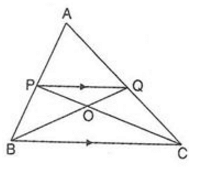
- a)9/25
- b)4/9
- c)25/9
- d)9/4
Correct answer is option 'D'. Can you explain this answer?
In the given figure if 

a)
9/25
b)
4/9
c)
25/9
d)
9/4
|
|
Krishna Iyer answered |
 In ΔPOQ and ΔCOB, ∠PQO = ∠QBO
In ΔPOQ and ΔCOB, ∠PQO = ∠QBO[Alternate angles] ∠POO = ∠COB [Vertically Opposite]

.[AA similarity]

Two isosceles triangles have equal angles and their areas are in the ratio 16 : 25. Then, the ratio of their corresponding heights is- a)3/5
- b)5/4
- c)5/7
- d)4/5
Correct answer is option 'D'. Can you explain this answer?
Two isosceles triangles have equal angles and their areas are in the ratio 16 : 25. Then, the ratio of their corresponding heights is
a)
3/5
b)
5/4
c)
5/7
d)
4/5

|
Lekshmi Mishra answered |
Let two isosceles triangles be ΔABC and ΔDEF And their corresponding altitudes are AM and DN.
Since the corresponding angles of both triangles are equal.
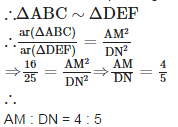
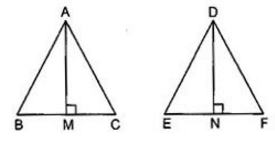
Since the corresponding angles of both triangles are equal.
The ratio of the corresponding sides of two similar triangles is 1 : 3. The ratio of their corresponding heights is :- a)1 : 3
- b)3 : 1
- c)1 : 9
- d)9 : 1
Correct answer is option 'A'. Can you explain this answer?
The ratio of the corresponding sides of two similar triangles is 1 : 3. The ratio of their corresponding heights is :
a)
1 : 3
b)
3 : 1
c)
1 : 9
d)
9 : 1
|
|
Nabanita Kaur answered |
Explanation:
Given that, the ratio of the corresponding sides of two similar triangles is 1 : 3.
Let us consider, the two similar triangles ABC and DEF.
Let AB and DE denote the corresponding sides of the triangles ABC and DEF.
Then, we have AB:DE = 1:3.
Now, let h1 and h2 denote the corresponding heights of the triangles ABC and DEF.
Then, we have h1/h2 = AB/DE = 1/3.
Therefore, the ratio of their corresponding heights is 1:3.
Hence, the correct option is (A).
Key Points:
- The ratio of corresponding sides of similar triangles is equal to the ratio of their corresponding heights.
- In this question, the given ratio of corresponding sides is 1:3, which gives the ratio of heights as 1:3.
Given that, the ratio of the corresponding sides of two similar triangles is 1 : 3.
Let us consider, the two similar triangles ABC and DEF.
Let AB and DE denote the corresponding sides of the triangles ABC and DEF.
Then, we have AB:DE = 1:3.
Now, let h1 and h2 denote the corresponding heights of the triangles ABC and DEF.
Then, we have h1/h2 = AB/DE = 1/3.
Therefore, the ratio of their corresponding heights is 1:3.
Hence, the correct option is (A).
Key Points:
- The ratio of corresponding sides of similar triangles is equal to the ratio of their corresponding heights.
- In this question, the given ratio of corresponding sides is 1:3, which gives the ratio of heights as 1:3.
Triangle ABC is such that AB = 9 cm, BC = 6 cm, AC = 7.5 cm. Triangle ΔDEF is similar to ABC, If EF= 12 cm then DE is :- a)6 cm
- b)16 cm
- c)18 cm
- d)15 cm
Correct answer is option 'C'. Can you explain this answer?
Triangle ABC is such that AB = 9 cm, BC = 6 cm, AC = 7.5 cm. Triangle ΔDEF is similar to ABC, If EF
= 12 cm then DE is :
a)
6 cm
b)
16 cm
c)
18 cm
d)
15 cm
|
|
Anuj Gupta answered |
Given that ABC is similar to DEF.
therefore, AB/BC=DE/EF = 9/6 = DE/12
= 12×9/6=DE
DE=18.
therefore, AB/BC=DE/EF = 9/6 = DE/12
= 12×9/6=DE
DE=18.
If ΔABC ∼ ΔEDF and ΔABC is not similar to ΔDEF, then which of the following is not true?- a)BC . DE = AB .EF.
- b)AB . EF = AC . DE.
- c)BC . EF = AC . FD.
- d)BC . DE = AB .FD.
Correct answer is option 'A'. Can you explain this answer?
If ΔABC ∼ ΔEDF and ΔABC is not similar to ΔDEF, then which of the following is not true?
a)
BC . DE = AB .EF.
b)
AB . EF = AC . DE.
c)
BC . EF = AC . FD.
d)
BC . DE = AB .FD.

|
Raksha Chopra answered |
If ΔABC ∼ ΔEDF and ΔABC is not similar to ΔDEF,ΔDEF,then BC. DE = AB .EF 
Here according to given condition, BC. DE ≠ AB .EF
Here according to given condition, BC. DE ≠ AB .EF
In an equilateral triangle ABC, if AD⊥BC,then- a)5AB2 = 4AD2.
- b)4AB2 = 3AD2.
- c)3AB2 = 4AD2.
- d)2AB2 = 3AD2.
Correct answer is option 'C'. Can you explain this answer?
In an equilateral triangle ABC, if AD⊥BC,then
a)
5AB2 = 4AD2.
b)
4AB2 = 3AD2.
c)
3AB2 = 4AD2.
d)
2AB2 = 3AD2.

|
Sushant Sen answered |
Since the internal bisector of an angle of a triangle divides the opposite side internally in the ratio of the sides containing the angle.
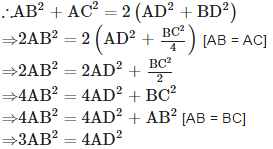
The length of the side of a rhombus whose diagonals are of lengths 24 cm and 10 cm is- a)17 cm.
- b)14 cm.
- c)13 cm.
- d)16 cm.
Correct answer is option 'C'. Can you explain this answer?
The length of the side of a rhombus whose diagonals are of lengths 24 cm and 10 cm is
a)
17 cm.
b)
14 cm.
c)
13 cm.
d)
16 cm.
|
|
Gaurav Kumar answered |
Let ABCD be the required rhombus whose diagonals are AC = 10 cm and BD = 24 cm. Let AC and BD intersect each other at O.
Then AB = BC = CD = DA
Also AO = CO = 10/2 = 5 cm
And BO = DO = 24/2 = 12 cm

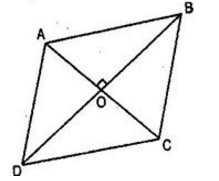
Then AB = BC = CD = DA
Also AO = CO = 10/2 = 5 cm
And BO = DO = 24/2 = 12 cm
Chapter doubts & questions for Triangles - Mathematics (Maths) Class 10 2025 is part of Class 10 exam preparation. The chapters have been prepared according to the Class 10 exam syllabus. The Chapter doubts & questions, notes, tests & MCQs are made for Class 10 2025 Exam. Find important definitions, questions, notes, meanings, examples, exercises, MCQs and online tests here.
Chapter doubts & questions of Triangles - Mathematics (Maths) Class 10 in English & Hindi are available as part of Class 10 exam.
Download more important topics, notes, lectures and mock test series for Class 10 Exam by signing up for free.

Contact Support
Our team is online on weekdays between 10 AM - 7 PM
Typical reply within 3 hours
|
Free Exam Preparation
at your Fingertips!
Access Free Study Material - Test Series, Structured Courses, Free Videos & Study Notes and Prepare for Your Exam With Ease

 Join the 10M+ students on EduRev
Join the 10M+ students on EduRev
|

|
Create your account for free
OR
Forgot Password
OR
Signup to see your scores
go up within 7 days!
Access 1000+ FREE Docs, Videos and Tests
Takes less than 10 seconds to signup





